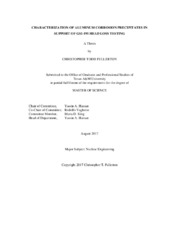| dc.description.abstract | In the event that a nuclear core cooling pipe ruptures, a loss of coolant accident (LOCA) scenario begins. Precipitates from dissolved ions can form and cause the emergency backup pumps to fail. Two aluminum products, an aluminum oxyhydroxide (AlOOH) and aluminum oxide solid are expected to have the greatest impact on debris bed formation. The objective of this experimental study was to classify these compounds by size, structure, and behavioral characteristics, and compare them to a benchtop salt generated precipitate made with aluminum nitrate nonahydrate. The source of the aluminum ions varies by plant, but they typically originate from corrosion of structures in the reactor containment environment. Characterizing the aluminum corrosion product is necessary to determine if an aluminum surrogate salt precipitate product can be substituted in the Nuclear Regulatory Commission’s (NRC) generic safety issue-191 (GSI-191) head loss testing to simplify testing procedures. If the surrogate salt product is comparable to the alloy corrosion product, it will simplify the task of studying sump strainer debris bed formation in future testing.
The representative post LOCA coolant solution for this experimental study was created at varying pH’s representative of containment chemistry. Aluminum samples were corroded at 85℃ ± 2℃ until the solubility limit was reached. The aluminum source was removed and the solution was cooled to 25℃ at three different cooling rates. The resulting solution was analyzed for turbidity, particle size, TEM, XRD, and settling characteristics. These results are compared to an aluminum nitrate nonahydrate surrogate salt precipitate prepared according to industry standards and regulations. The characterization of the precipitates proved to be dependent on corrosion pH, aluminum ion concentration, and cooling rate. The cooling rate dynamics indicate a higher probability of large precipitate formation during slow cooling rates and smaller particle formation during rapid cooling rates. The quantity of particles generated was assessed with solution turbidity. The solutions with higher concentrations of aluminum ions resulted in higher solution turbidity. The AlOOH precipitates from the Al(NO3)3·9H2O salt solution were determined to be a suitable substitute for further head loss testing in the chemical GSI-191 project. | en |


